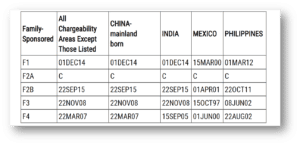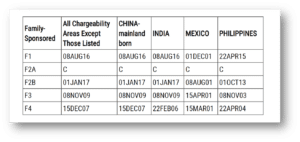Congress establishes a cap on the number of green cards or immigrant visas that can be issued each year. There are 366,000 immigrant visas available annually. This number is divided into two broad categories of Family-Based visa (FB) cases and Employment-Based visa (EB) cases. These broad categories are further divided based on the categories set by Congress. More on those categories below.
Additionally, Congress has set a “country cap”. That means no single country of origin can account for more than 7% of the green cards issued in any particular category. This affects four countries that have a large number of nationals migrating to the United States. These nations are Mainland China, India, Mexico, and the Philippines. The number of visas available for the four nations listed and the rest of the world each year has continued to exceed the annual limit set by Congress, creating a backlog. Thus, the need for the Visa Bulletin was created. The Department of State publishes a monthly visa bulletin. The visa bulletin lets you know when it is time to file for your green card or apply for an immigrant visa abroad. This article/guide will focus on how to read the Family-Based visa bulletins.
The Family-Preference category
U.S. citizens and lawful permanent residents can help certain family members immigrate to the United States. This is a two-step process. First, the U.S. citizen or lawful permanent resident (green card holder) files a family visa petition. Second, the foreign national relative files an application to become a permanent resident. These available immigrant visas fall under the Family-Based visa (FB) cases. Congress has allocated 226,000 immigrant visas for Family-based visa cases. These available visas are broken down into several categories. In the FB category, Congress has carved out one exception with an unlimited number of visas for immediate relatives. These relatives have special immigration priority and there is no limit on the number of visas available for immediate relatives. Immediate relatives of a U.S. citizen include the Spouse, Unmarried child(ren) under the age of 21, and Parent (if the U.S. citizen is over the age of 21). Apart from immediate relatives, there are five Preference Categories set up by Congress. Each intending immigrant falls into a certain category based on his or her relationship with the petitioner (the U.S. citizen or green card holder). Below are the categories:
- First Preference (F1): Unmarried, adult sons and daughters (age 21 or over) of U.S. citizens
- The cap for this category is 23,400 green cards per year
- Second Preference (F2): Spouses and unmarried children of green card holders.
- The overall cap for this category is 114,200 green cards per year, but it’s split into two subcategories:
- Second Preference A (F2A): F2A: Spouses and unmarried children (under 21) of permanent residents
- 77% of the F2 quota goes towards F2A (e., 87,934 green cards per year)
- Second Preference B (F2B): F2B: Unmarried adult sons and daughters of permanent residents
- 23% of the F2 quota goes towards F2B (e., 26,266 green cards per year)
- Second Preference A (F2A): F2A: Spouses and unmarried children (under 21) of permanent residents
- The overall cap for this category is 114,200 green cards per year, but it’s split into two subcategories:
- Third Preference (F3): Married sons and daughters (any age) of U.S. citizens, their spouses, and their minor children.
- The cap for this category is 23,400 green cards per year
- Fourth Preference(F4): Brothers and sisters of adult U.S. citizens, their spouses, and their minor children
- The cap for this category is 65,000 green cards per year
What are the common terms used in the visa bulletin? What must I know to read the visa bulletin terms properly?
As mentioned above, the first step for a U.S. citizen or a green card holder (petitioner) starting the process to help immigrate their family members (beneficiary) is filing a visa petition. This step requires filing an I-130, Petition for Alien Relative by the petitioner on behalf of the beneficiary. Below are key common terms to know to help you read and understand the Family-Based visa bulletin.
Priority date: The filing date of an I-130 petition becomes the applicant’s priority date. When U.S. Citizenship and Immigration Services (USCIS) accept Form I-130, they will also assign a priority date.
Current (C): Simply means that there is no backlog and no wait time for a green card. Whenever a particular priority date becomes “current” it means it is at the front of the line. If your I-130 petition is now current, you may apply for permanent residence (green card) in the United States.
Unauthorized (U): This occurs occasionally when visa numbers are not unauthorized for issuance.
Chargeability area: This term is used for the green card applicant’s country of birth. It is important as there are also additional country caps. Applicant’s green cards will be “charged” toward the annual quota of green cards available to citizens of their country of birth.
Immediate relative: A spouse, parent, or unmarried child (under 21) of a U.S. citizen.
Cut-off date: The dates you see on the visa bulletin tables are called “cut-off dates.” These dates are essentially the front of the green card line. Applicants with priority dates prior to the cut-off date can submit their green card applications.
Usually, the cut-off dates on the visa bulletin move forward in time, but they might go backward. Visa retrogression happens in a situation when there is overdemand in some particular category or country for that month. The Visa Bulletin tables provide “cut-off dates.” This date is the front of the green card line. If your priority date is before/earlier than the cut-off date – then you can apply for a green card. If your priority date is after/later than the cut-off date, you need to keep waiting.
How To Read the Visa Bulletin
Once you know your priority date and your preference category, you are all set to read the visa bulletin. When the State Department release the visa bulletin for each month, they release two charts/tables. For Family-based visa cases, the first chart is titled Final Action Dates for Family-Sponsored Preference Cases (Final Action Dates). The second is the Date for Filing Family-Sponsored Visa Applications (Date of Filing). Each table has separate columns for China, India, Mexico, and the Philippines, and these countries typically have much longer wait times for a green card. This is because the annual demand for green cards exceeds the 7% “country cap” described above. Once you know your priority date, your preference category, and the country of origin; the next question is which table to use to determine the next steps in your case.
A. FINAL ACTION DATES FOR FAMILY-SPONSORED PREFERENCE CASES
The Final Action Dates chart shows priority dates that have reached the front line and are ready for approval. In other words, a visa number is available if a priority date comes before the date listed in this chart. Below is an example from the October 2022 Visa bulletin:
To illustrate how to read the above table, we will use the below example of I-130 approval:

B. DATES FOR FILING FAMILY-SPONSORED VISA APPLICATIONS
The second chart indicates when the intending immigrant can apply for an immigrant visa. It shows which group of intending immigrants can go ahead and submit their application with the National Visa Center (NVC)—even though a green card is not ready just yet. Intending immigrant applicants living in the United States can check a page called “When to file your adjustment of status application” published by USCIS every month. It indicates they can submit their green card application based on the visa bulletin’s “dates for filing” chart or whether they need to wait to meet the dates in the “final action dates” chart.
The Dates for Filing chart is primarily directed at people who will be applying for a green card from outside of the United States. The Date of Filing chart is slightly behind (6-12 months) the Final Action Chart. Thus, this chart allows them to get an early start on assembling and submitting all the required documents to NVC. This enables NVC sufficient time to review the documents and saves time for the intending immigrant so when a visa is available per the Final Action Chart, he or she can attend to potentially receive his/her green card.
Below is an example from the October 2022 Visa bulletin:
To illustrate how to read the above table, we will use the below example of I-130 approval:

Conclusion
Filing for a relative can be a long, confusing, stressful, but crucial step. Understanding how to read the information provided to ensure you are taking timely action is key. We know how important it is to have the right advice to complete the process in a timely manner, and in full compliance with immigration requirements to increase your odds of a positive outcome. Please contact us to ensure you get the right guidance for your specific situation. We are in this together.



